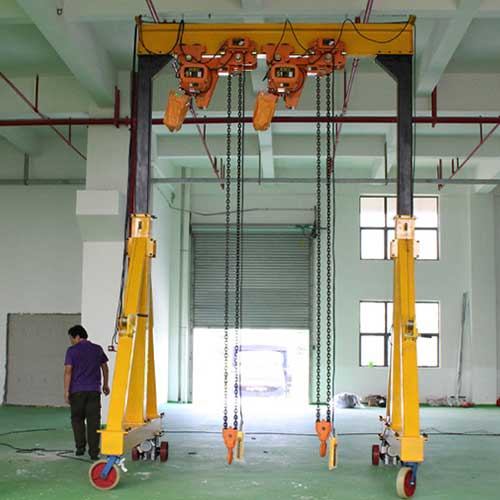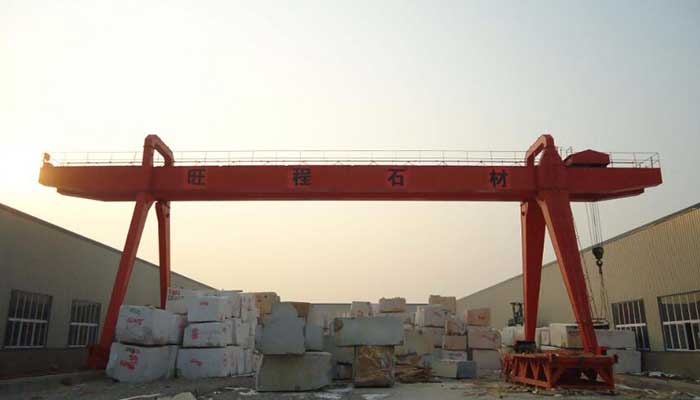Types of 5 Ton &10 Ton Gantry Cranes, Select Right Design for Your Facility
5 ton & 10 ton gantry cranes with single girder / double girders comparison to select right design of 5 ton and 10 ton gantry crane for your facility.
Category: 5 Ton Gantry Crane
Your Trusted Overhead Gantry Crane Manufacturer & Supplier
Types of 5 Ton &10 Ton Gantry Cranes, Select Right Design for Your Facility
5 ton & 10 ton gantry cranes with single girder / double girders comparison to select right design of 5 ton and 10 ton gantry crane for your facility.
5 Ton vs. 10 Ton Gantry Crane: Which Is More Suitable for Your Facility?
As for 5 ton and 10 ton gantry cranes, there are single girder crane and double girder crane designs. As for different applications, which is more suitable for your facility, the single girder 5 ton gantry crane and 10 ton gantry crane or the double girder 5 ton gantry crane or 10 ton gantry cranes?
Overview of facility-specific gantry crane needs
Gantry cranes, with their remarkable versatility and robust lifting capabilities, are indispensable in a wide range of industries and facility types. These industrial workhorses provide the muscle required to move heavy loads, ensuring the smooth flow of materials and enhancing productivity within various environments. However, the choice between different gantry crane capacities is not a one-size-fits-all decision. To optimize material handling operations, it's crucial to align the crane's capacity with specific facility requirements.
The Pivotal Role of Capacity Selection in Facility Operations
Selecting the appropriate gantry crane capacity is a pivotal decision in the realm of facility operations. It impacts the efficiency, safety, and overall functionality of the material handling process. A crane with insufficient capacity may lead to operational bottlenecks and safety risks, while an over-capable crane could result in unnecessary costs and space constraints. Hence, understanding and tailoring the crane's capacity to the unique needs of a facility is paramount.
Introduction to the Comparison between 5-Ton and 10-Ton Gantry Cranes Tailored to Different Facility Conditions
In this article, we embark on a journey through the world of gantry cranes, focusing on the selection between two common capacities: 5 tons and 10 tons. These two capacities represent significant options for various facilities, each with its own set of advantages and considerations. As we delve into the comparison, we'll explore how facility conditions and specific application environments influence the choice between these capacities. Let's discover which of these gantry cranes is more suitable for your facility's unique requirements.
Facility-Specific Considerations for Gantry Crane Capacity
Overview of Crane Facility
The term crane facility refers to a location or area within an industrial or commercial setting where cranes are used for material handling and lifting purposes. Crane facilities are essential in various industries and applications, and they are typically equipped with different types of cranes, depending on the specific needs of the facility. As for gantry cranes, they are typical used in the following crane facilities:
Gantry cranes are versatile lifting equipment used in a variety of crane facilities and industrial settings where heavy material handling and precise positioning are required. Here are some common types of crane facilities where gantry cranes are required or commonly used:
- 1. Manufacturing Facilities: Gantry cranes are frequently used in manufacturing plants to move raw materials, heavy machinery components, and finished products. They help streamline production processes and enhance efficiency.
- 2. Warehouses and Distribution Centers: Gantry cranes are essential for loading and unloading goods from trucks, stacking and retrieving pallets, and optimizing storage space in warehouses and distribution centers.
- 3. Construction Sites: Construction sites utilize gantry cranes for lifting and placing heavy construction materials, equipment, and structural elements such as steel beams and concrete blocks. Mobile gantry cranes are often used for their portability.
- 4. Ports and Harbors: Ports and harbors rely on gantry cranes for container handling, cargo loading and unloading from ships, and transporting goods from the waterfront to storage yards.
- 5. Aerospace Facilities: Gantry cranes with precision controls are used in aerospace manufacturing and maintenance facilities to handle aircraft components, engines, and other heavy and delicate materials.
- 6. Steel Mills: Steel mills employ heavy-duty gantry cranes for handling molten metal, steel coils, and other large loads. These cranes are crucial for the steel production process.
- 7. Mining Operations: Mines use gantry cranes for extracting minerals, moving heavy mining equipment, and transporting ore and waste materials within the mining site. They are vital for maintaining productivity in the mining industry.
- 8. Automotive Manufacturing: Automotive plants utilize gantry cranes for vehicle assembly, handling automotive components, and managing raw materials. Gantry cranes contribute to the efficient production of automobiles.
- 9. Petrochemical and Refinery Facilities: Gantry cranes are used in petrochemical and refinery facilities for maintenance and repair of equipment, as well as for handling heavy vessels and machinery components.
- 10. Shipyards: Shipbuilding and repair yards employ large gantry cranes to construct, repair, and move ships and vessels. These cranes have the capacity to lift and position entire ship sections.
- 11. Railway Facilities: Gantry cranes are used in railway maintenance and repair facilities for lifting and positioning locomotives, railcars, and track components.
- 12. Power Plants: Power generation facilities, including nuclear, thermal, and hydroelectric power plants, use gantry cranes for various tasks such as handling turbines, generators, and maintenance operations.
- 13. Container Yards: Container yards at logistics and transportation hubs utilize gantry cranes, often called container gantry cranes (CGCs), to stack, load, and unload shipping containers from trucks and vessels.
- 14. Woodworking and Sawmills: Gantry cranes are used in woodworking facilities and sawmills for handling large logs, lumber, and heavy machinery.
- 15. Material Recycling Centers: Recycling facilities use gantry cranes to efficiently sort, move, and process recyclable materials such as metals and paper.
These are just some examples of crane facilities where gantry cranes play a crucial role in material handling, lifting, and transport operations. Gantry cranes are favored for their adaptability, capacity, and ability to work in diverse industrial environments.
Facility and Workspace Conditions Impacting Gantry Crane Choice
In the world of material handling, facility conditions play a pivotal role in determining the appropriate gantry crane capacity. Understanding and adapting to these conditions is essential for ensuring that the crane meets the specific needs of the workspace. Here are two key aspects of facility conditions that significantly influence gantry crane choice:
1. Space Limitations
Facility layouts can vary significantly, and some workspaces may be limited in terms of available space. In such cases, the physical footprint of the gantry crane becomes a critical factor. The 5-ton and 10-ton gantry cranes may have different dimensions, and the choice between them should consider the available floor space for installation and maneuvering. Selecting a crane that fits comfortably within the facility's layout is essential for efficient material handling operations.
2. Ceiling Height and Clearance
Ceiling height and clearance are factors that impact the vertical operation of gantry cranes. Facilities with lower ceiling heights may have restrictions on the crane's hook height and its ability to lift loads to optimal positions. Gantry cranes require sufficient clearance to operate safely. The choice between a 5-ton and 10-ton crane should consider whether the facility can accommodate the required hook height and whether the ceiling clearance is compatible with the crane's design.
Specialized Application Environments That Dictate Capacity Requirements
Gantry cranes are deployed in a wide range of application environments, each with its own unique material handling challenges. These environments can dictate specific capacity requirements based on the nature of the loads, the frequency of lifts, and safety considerations. Here are two types of specialized application environments that often influence gantry crane capacity choices:
1. Industrial Settings
Different industries have varying demands for material handling. For example, the steel industry may require gantry cranes with higher lifting capacities due to the substantial weight of steel coils, while a smaller manufacturing facility may primarily handle lighter loads. Understanding the industrial context in which the crane will operate is essential for selecting the appropriate capacity to meet the specific demands of the facility.
2. Unique Material Handling Challenges
Some facilities face unique material handling challenges that go beyond the norm. These challenges may involve irregularly shaped loads, hazardous materials, or intricate lifting maneuvers. In such cases, the crane's capacity must be carefully chosen to ensure not only the safe lifting of loads but also the precision and adaptability required to address these challenges effectively.
The Imperative of Aligning Crane Capacity with Facility Conditions for Seamless Operations
In conclusion, the choice of gantry crane capacity should be a meticulous process that takes into account the unique facility and workspace conditions. By assessing space limitations, ceiling height, and clearance, as well as considering the specialized application environments and material handling challenges, facility managers and operators can align the crane's capacity with the facility's conditions. This alignment is essential for achieving seamless operations, maximizing efficiency, and ensuring the safe and effective handling of materials within the facility. In the following sections, we will explore how the 5-ton and 10-ton gantry cranes can be tailored to different facility conditions, further aiding in the selection process.
Types of 5 ton gantry cranes and 10 ton gantry cranes
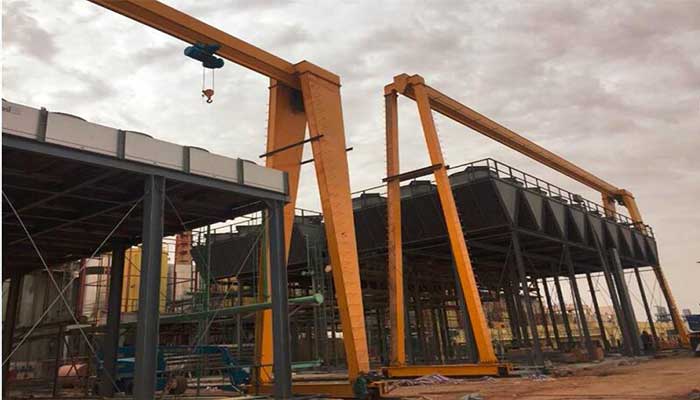
5 ton single girder gantry crane, which are the most frequently used crane design for 5 ton loads or object handling
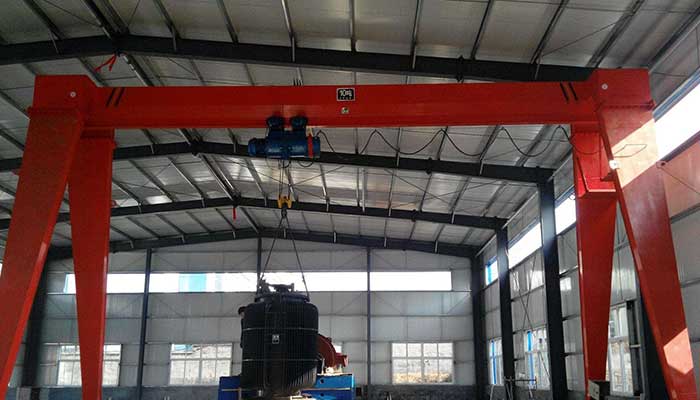
10 ton single girder gantry cranes can be used for material handling with shorter span and heavy duty lifting , compared with 5 ton single girder gantry crane
Single girder crane design
When comparing a 5-ton gantry crane and a 10-ton gantry crane with single girder design and the same crane specifications, it's essential to evaluate their differences in terms of lifting capacity, structural requirements, and suitability for various applications. Here's a detailed comparison:
1. Lifting Capacity:
- 5-Ton Gantry Crane: The 5-ton gantry crane is designed to lift a maximum load of 5 tons (10,000 pounds). This capacity is suitable for handling moderately heavy loads, making it ideal for small to medium-sized manufacturing facilities, workshops, and warehouses.
- 10-Ton Gantry Crane: The 10-ton gantry crane, with its doubled capacity, can lift loads of up to 10 tons (20,000 pounds). This higher lifting capacity makes it suitable for more substantial and heavier loads, often found in large manufacturing plants, industrial facilities, and construction sites.
2. Structural Requirements:
- 5-Ton Gantry Crane: Since it has a lower lifting capacity, the structural requirements for a 5-ton gantry crane are less demanding. It typically has a lighter frame, smaller beams, and less robust components. This results in a crane that is more space-efficient and cost-effective.
- 10-Ton Gantry Crane: Due to its higher lifting capacity, the 10-ton gantry crane requires a more robust and heavy-duty structure. It features larger and stronger beams, thicker steel components, and a sturdier design overall. This increased structural integrity ensures the crane's ability to handle heavier loads safely.
3. Application Suitability:
- 5-Ton Gantry Crane: The 5-ton gantry crane is well-suited for applications that involve moderately heavy loads and where precision and versatility are essential. It is commonly used in small manufacturing facilities, maintenance workshops, and warehouses for tasks such as equipment assembly, material handling, and maintenance.
- 10-Ton Gantry Crane: The 10-ton gantry crane is ideal for heavy-duty industrial applications where lifting very heavy loads is a regular requirement. It is commonly found in large manufacturing plants, construction sites, and shipyards for tasks such as moving steel beams, machinery, and oversized components.
4. Cost Considerations:
- 5-Ton Gantry Crane: The 5-ton gantry crane is generally more cost-effective both in terms of its initial acquisition cost and potential infrastructure modifications. It is a budget-friendly option for facilities with limited financial resources.
- 10-Ton Gantry Crane: The 10-ton gantry crane comes with a higher initial cost due to its heavier-duty components and increased lifting capacity. Additionally, it may require more extensive infrastructure modifications to support its larger size and weight.
In summary, while both the 5-ton and 10-ton gantry cranes with single girder designs share certain specifications, they differ significantly in terms of lifting capacity, structural requirements, application suitability, and cost considerations. The choice between these two cranes should be based on the specific needs and requirements of your facility, taking into account the types of loads you handle, available space, budget constraints, and the necessary structural support.
Double girder crane design
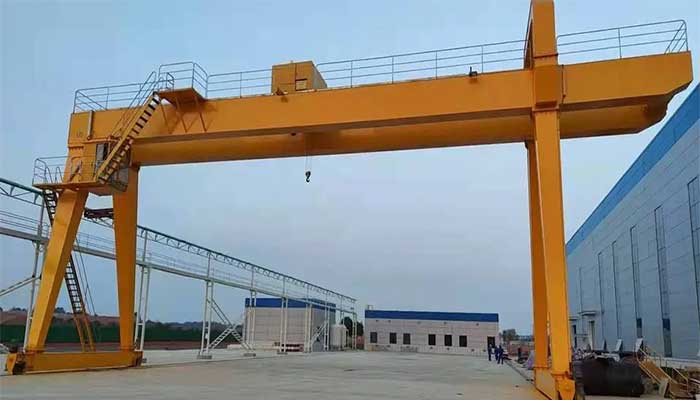
5 ton double girder gantry crane, compared with 5 ton single girder gantry crane, can be used for material handling with longer span or heavier weight
When comparing a 5-ton gantry crane and a 10-ton gantry crane with double girder design and the same crane specifications, it's important to consider factors such as lifting capacity, structural requirements, and suitability for various applications. Here's a detailed comparison:
1. Lifting Capacity:
- 5-Ton Double Girder Gantry Crane: The 5-ton double girder gantry crane is designed to lift a maximum load of 5 tons (10,000 pounds). This capacity makes it suitable for a wide range of applications that require lifting moderately heavy loads.
- 10-Ton Double Girder Gantry Crane: The 10-ton double girder gantry crane, with its doubled capacity, can lift loads of up to 10 tons (20,000 pounds). This higher lifting capacity is ideal for handling heavier loads commonly found in industrial and manufacturing settings.
2. Structural Requirements:
- 5-Ton Double Girder Gantry Crane: Double girder gantry cranes are inherently more robust due to their dual beam design. The 5-ton double girder gantry crane features larger and stronger beams, thicker steel components, and a sturdier overall structure to support its lifting capacity.
- 10-Ton Double Girder Gantry Crane: Similar to the 5-ton double girder gantry crane, the 10-ton version has a heavy-duty structural design. It features even larger and more robust beams, thicker steel components, and additional reinforcement to accommodate its higher lifting capacity.
3. Application Suitability:
- 5-Ton Double Girder Gantry Crane: The 5-ton double girder gantry crane is suitable for a wide range of applications, including manufacturing, maintenance, and material handling tasks that involve moderately heavy loads. It provides enhanced stability and precision.
- 10-Ton Double Girder Gantry Crane: The 10-ton double girder gantry crane is specifically designed for heavy-duty industrial applications where lifting very heavy loads is a regular requirement. It excels in industries such as steel mills, shipbuilding, and construction.
4. Cost Considerations:
- 5-Ton Double Girder Gantry Crane: The 5-ton double girder gantry crane typically comes with a higher initial cost compared to a single girder design due to its heavier-duty structural components. It may also require more extensive infrastructure modifications.
- 10-Ton Double Girder Gantry Crane: The 10-ton double girder gantry crane has a higher initial cost than the 5-ton double girder version due to its increased lifting capacity and heavier structural components. Infrastructure modifications may also be more extensive and costly.
In summary, both the 5-ton and 10-ton double girder gantry cranes offer increased lifting capacity and enhanced stability compared to their single girder counterparts. The choice between these two cranes should be based on the specific needs and requirements of your facility, taking into account the types of loads you handle, available space, budget constraints, and the necessary structural support. Generally, the 10-ton double girder gantry crane is favored for heavier industrial applications, while the 5-ton version is suitable for a broader range of tasks.
5-Ton Single Girder Gantry Crane vs. 5-Ton Double Girder Gantry Crane:
Similarities:
- Both are types of gantry cranes designed for a 5-ton lifting capacity.
- They can be customized to suit specific industry and application requirements.
- Available in various spans and heights to accommodate different workspace configurations.
- Offer efficient material handling solutions for industries like manufacturing, logistics, and construction.
Differences:
| Aspect | Single Girder Gantry Crane | Double Girder Gantry Crane |
|---|---|---|
| Girder Configuration | Single horizontal girder | Two parallel horizontal girders |
| Load Capacity | Typically up to 5 tons | Typically up to 5 tons, with potential for higher capacities |
| Lifting Height | Generally limited to a specific height | Offers greater lifting height flexibility |
| Cost and Complexity | Generally lower initial cost and simpler design | Higher initial cost due to double girder structure, but robust |
| Maintenance and Service Access | Easier accessibility for maintenance tasks | Maintenance may be more complex due to two girders |
| Stability and Load Distribution | Slightly less stability under heavy loads | Enhanced stability, suitable for heavier loads |
| Application Environments | Well-suited for light to moderate duty applications | Ideal for heavy-duty and demanding applications |
| Speed and Precision | Offers adequate speed and precision | Enhanced precision and potentially higher speeds |
| Longevity and Durability | Generally has a shorter lifespan compared to double girder | Longer service life due to robust construction |
| Customization Options | May offer fewer customization options | Greater potential for customization and special features |
While both types of gantry cranes serve the purpose of lifting and material handling, the choice between a single girder and a double girder gantry crane depends on the specific requirements of the industry, the loads being handled, and the desired level of performance and longevity. Single girder gantry cranes are cost-effective for moderate-duty applications, whereas double girder gantry cranes excel in heavy-duty settings and offer more versatility.
10-Ton Single Girder Gantry Crane vs. 10-Ton Double Girder Gantry Crane:
Similarities:
- Both are types of gantry cranes designed for a 10-ton lifting capacity.
- They can be customized to suit specific industry and application requirements.
- Available in various spans and heights to accommodate different workspace configurations.
- Offer efficient material handling solutions for industries like manufacturing, logistics, and construction.
Differences:
| Aspect | Single Girder Gantry Crane | Double Girder Gantry Crane |
|---|---|---|
| Girder Configuration | Single horizontal girder | Two parallel horizontal girders |
| Load Capacity | Typically up to 10 tons | Typically up to 10 tons, with potential for higher capacities |
| Lifting Height | Generally limited to a specific height | Offers greater lifting height flexibility |
| Cost and Complexity | Generally lower initial cost and simpler design | Higher initial cost due to double girder structure, but robust |
| Maintenance and Service Access | Easier accessibility for maintenance tasks | Maintenance may be more complex due to two girders |
| Stability and Load Distribution | Slightly less stability under heavy loads | Enhanced stability, suitable for heavier loads |
| Application Environments | Well-suited for light to moderate duty applications | Ideal for heavy-duty and demanding applications |
| Speed and Precision | Offers adequate speed and precision | Enhanced precision and potentially higher speeds |
| Longevity and Durability | Generally has a shorter lifespan compared to double girder | Longer service life due to robust construction |
| Customization Options | May offer fewer customization options | Greater potential for customization and special features |
Portable gantry crane designs

5 ton + 5 ton portable gantry crane with short span
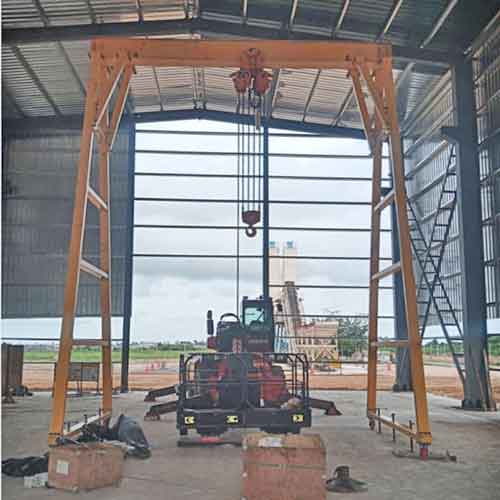
10 ton portable gantry cranes, short span and reinforced gantry leg design
When comparing a 5-ton portable gantry crane and a 10-ton portable gantry crane with the same crane specifications, it's essential to consider factors such as lifting capacity, portability, structural design, and suitability for various applications. Here's a detailed comparison:
1. Lifting Capacity:
- 5-Ton Portable Gantry Crane: The 5-ton portable gantry crane is designed to lift a maximum load of 5 tons (10,000 pounds). This capacity makes it suitable for a wide range of light to moderately heavy lifting tasks in various industries.
- 10-Ton Portable Gantry Crane: The 10-ton portable gantry crane, with its doubled capacity, can lift loads of up to 10 tons (20,000 pounds). This higher lifting capacity is ideal for handling significantly heavier loads commonly found in industrial and manufacturing settings.
2. Portability:
- 5-Ton Portable Gantry Crane: Portable gantry cranes are designed for easy transport and mobility within a facility. The 5-ton version is relatively lightweight and can be moved to different workstations or locations as needed.
- 10-Ton Portable Gantry Crane: While portable, the 10-ton gantry crane is larger and heavier than the 5-ton version due to its higher lifting capacity. It may require additional effort or equipment for relocation.
3. Structural Design:
- 5-Ton Portable Gantry Crane: Portable gantry cranes are typically designed with simplicity in mind. The 5-ton portable gantry crane features a sturdy yet lightweight frame, making it easy to assemble and disassemble for transportation.
- 10-Ton Portable Gantry Crane: The 10-ton portable gantry crane, due to its higher capacity, has a more robust structural design. It features larger and stronger components to support the increased load capacity.
4. Application Suitability:
- 5-Ton Portable Gantry Crane: The 5-ton portable gantry crane is versatile and suitable for a wide range of applications, including workshops, warehouses, and smaller manufacturing facilities. It can handle a variety of loads, making it a flexible choice.
- 10-Ton Portable Gantry Crane: The 10-ton portable gantry crane is specifically designed for heavy-duty industrial applications where lifting very heavy loads is common. It excels in industries such as construction, shipbuilding, and steel fabrication.
5. Cost Considerations:
- 5-Ton Portable Gantry Crane: The 5-ton portable gantry crane is generally more cost-effective both in terms of its initial acquisition cost and potential transportation requirements. It is a budget-friendly option for facilities with light to moderately heavy lifting needs.
- 10-Ton Portable Gantry Crane: The 10-ton portable gantry crane has a higher initial cost due to its increased lifting capacity and larger structural components. Transportation costs may also be higher due to its size and weight.
In summary, both the 5-ton and 10-ton portable gantry cranes offer the advantage of portability and flexibility in various applications. The choice between these two cranes should be based on the specific needs and requirements of your facility, considering the types of loads you handle, available space, budget constraints, and the need for increased lifting capacity. The 10-ton portable gantry crane is ideal for heavy industrial lifting tasks, while the 5-ton version offers versatility and cost-effectiveness for lighter to moderately heavy loads.
5-Ton Portable Gantry Crane vs. 10-Ton Portable Gantry Crane:
What are the difference and similarity of 5 ton portable gantry crane and 10 ton portable gantry crane with similar specification except capacity?
Similarities:
Both are portable gantry cranes designed for easy mobility and quick setup in various locations.
They share similar structural designs, including adjustable height and span configurations.
Both offer an efficient and flexible solution for lifting and material handling tasks.
Portable gantry cranes in both capacities are versatile and can be used in various industrial settings.
Differences:
- Lifting Capacity: The primary difference is the lifting capacity. A 5-ton portable gantry crane can handle loads up to 5 tons, while the 10-ton counterpart is designed for heavier loads, with a capacity of up to 10 tons.
- Structural Reinforcement: To accommodate the increased weight capacity, the 10-ton portable gantry crane typically features a more robust and reinforced structure, including thicker beams and stronger components.
- Lifting Height: The 10-ton portable gantry crane may have a higher lifting height to handle larger loads and reach greater heights, whereas the 5-ton version is optimized for its specific capacity.
- Cost: Generally, the 10-ton portable gantry crane will have a higher initial cost compared to the 5-ton version due to the need for sturdier materials and construction.
- Application Range: While both are versatile, the 10-ton portable gantry crane is better suited for heavy-duty applications where larger and heavier loads are regularly handled. The 5-ton version is ideal for medium-duty tasks.
In summary, the key difference between the 5-ton and 10-ton portable gantry cranes is their lifting capacity. The 10-ton crane is designed for heavier loads and, as a result, features a more robust structure. The choice between them should be based on the specific requirements of the lifting tasks and the weight of the loads to be handled.
| Items | 5-Ton Portable Gantry Crane | 10-Ton Portable Gantry Crane |
|---|---|---|
| Lifting Capacity | Up to 5 tons | Up to 10 tons |
| Structural Design | Similar to 10-ton version, but lighter | Robust and reinforced structure |
| Lifting Height | Suited for medium lifting heights | May have a higher lifting height |
| Cost | Generally lower initial cost | Higher initial cost due to increased capacity |
| Application Range | Ideal for medium-duty tasks | Well-suited for heavy-duty applications |
5-Ton Gantry Crane in Facility Context
Description of a 5-ton gantry crane tailored to facility conditions
When it comes to facility conditions that demand careful consideration, the 5-ton gantry crane stands out as a versatile solution. It can be customized to suit various facility contexts, making it an ideal choice for specific environments. Here's an exploration of how a 5-ton gantry crane can be tailored to facility conditions:
1. Design Modifications for Space-Constrained Environments
In facilities with limited floor space, the 5-ton gantry crane can be designed with a more compact footprint. This modification ensures that the crane doesn't encroach on valuable workspace. By optimizing its dimensions, the crane can efficiently navigate through confined areas, allowing for seamless material handling in tight quarters.
2. Adaptations for Facilities with Lower Ceilings
In facilities where ceiling height is a constraint, the 5-ton gantry crane can be adapted to maximize vertical space utilization. Through innovative design and engineering, the crane's hook height can be optimized to work efficiently within the available ceiling clearance. This ensures that the crane can operate safely without compromising on lifting capacity.
Facility-Specific Applications and Settings for 5-Ton Gantry Cranes
The 5-ton gantry crane finds its utility in a wide range of facility-specific applications and settings. Its adaptability and moderate capacity make it a valuable asset in the following contexts:
1. Utilization in Compact Industrial Spaces
Facilities with limited square footage often benefit from the use of 5-ton gantry cranes. These cranes can navigate through congested industrial spaces, efficiently transporting materials, and optimizing workspace utilization. This adaptability is particularly valuable in industries such as small-scale manufacturing, workshops, and repair facilities.
2. Examples of Specialized Loads Managed in Unique Application Environments
The 5-ton gantry crane is well-suited to handle specialized loads in unique application environments. Whether it's delicately lifting precision machinery components in an aerospace facility or managing irregularly shaped materials in a manufacturing plant, the crane's adaptability and moderate capacity allow it to address diverse material handling challenges.
Advantages of a 5-Ton Gantry Crane in Addressing Facility-Specific Challenges
The 5-ton gantry crane offers several advantages when addressing facility-specific challenges:
Versatility: Its moderate capacity and adaptability make it suitable for a variety of facility conditions and material handling tasks.
Space Efficiency: Customized designs allow it to function optimally in space-constrained environments.
Safety: Careful engineering ensures that it operates safely within facilities with lower ceiling heights.
Limitations and Scenarios Where a 5-Ton Crane Is Insufficient, Considering Facility Conditions
While the 5-ton gantry crane excels in many facility contexts, it does have limitations. In scenarios involving extremely heavy or oversized loads, frequent high-capacity lifting, or industries with strict demands for heavier lifting equipment, a 5-ton gantry crane may prove insufficient. In such cases, facility managers may need to explore alternative capacity options, such as the 10-ton gantry crane, to meet their specific requirements. The choice ultimately hinges on a thorough assessment of the facility's unique conditions and material handling needs.
10-Ton Gantry Crane in Facility Context
Description of a 10-ton gantry crane tailored to facility conditions
In facilities with unique demands for heavier lifting, the 10-ton gantry crane emerges as a stalwart solution. Its robust design and increased capacity allow it to excel in various facility contexts. Here's an exploration of how a 10-ton gantry crane can be tailored to facility conditions:
1. Design Features for Handling Larger Loads in Spacious Facilities
For facilities with ample floor space and a requirement for handling larger and heavier loads, the 10-ton gantry crane can be designed with features optimized for these conditions. This may include reinforced structural components, higher-capacity hoists, and broader spans between legs. These design enhancements ensure that the crane can safely and efficiently manage substantial loads in spacious environments.
2. Considerations for Facilities with Ample Ceiling Clearance
In facilities with generous ceiling clearance, the 10-ton gantry crane can capitalize on its capacity by offering increased hook height. This enables the crane to lift loads to higher positions, optimizing storage and material handling within the facility. When ceiling height is not a limiting factor, the 10-ton gantry crane's capabilities are fully realized.
Facility-Specific Applications and Settings for 10-Ton Gantry Cranes
The 10-ton gantry crane finds its niche in facility-specific applications and settings where heavier lifting capacities are essential. Here are examples of contexts where the 10-ton gantry crane is particularly valuable:
1. Large-Scale Industrial Facilities and Expansive Workspaces
In industries such as steel manufacturing, shipbuilding, and large-scale construction, expansive facilities are common. These environments demand the lifting power of a 10-ton gantry crane to efficiently handle massive materials, components, and equipment. The crane's extended capacity ensures that operations run smoothly in vast workspaces.
2. Examples of Facility-Specific Loads That Demand the Capacity of a 10-Ton Crane
Certain facilities deal with loads that surpass the capabilities of lighter cranes. For instance, in shipyards, where massive ship sections and components must be maneuvered, the 10-ton gantry crane is indispensable. Similarly, foundries handling large castings and mining operations managing substantial ore loads rely on the crane's higher capacity to maintain productivity.
Advantages of a 10-Ton Gantry Crane in Facility Contexts with Specific Requirements
The 10-ton gantry crane offers several advantages in facility contexts with specific requirements:
High Capacity: Its ability to lift heavier loads enhances efficiency in facilities dealing with substantial materials.
Versatility: While built for heavy lifting, it can still handle a range of load sizes and types.
Height Capabilities: In facilities with ample ceiling clearance, it can reach higher positions for optimized material storage.
Limitations and Scenarios Where a 10-Ton Crane Might Be Excessive or Impractical, Considering Facility Conditions
Despite its impressive capacity, a 10-ton gantry crane may not always be the optimal choice. In facilities with limited space, lower ceiling heights, or where the majority of loads are within the capacity of a lighter crane, opting for a 10-ton crane may prove excessive and impractical. The choice between a 5-ton and 10-ton gantry crane should be a deliberate one, carefully aligning the crane's capacity with the specific needs and conditions of the facility.
Facility-Specific Comparative Analysis
Customized Head-to-Head Comparison of 5-Ton and 10-Ton Gantry Cranes Based on Facility Conditions
When evaluating the choice between a 5-ton and a 10-ton gantry crane for specific facility conditions, it's essential to conduct a customized comparison. Here's an in-depth look at how these two capacities stack up against each other in various aspects tailored to facility conditions:
1. Adaptability to Space Limitations and Confined Facilities
In facilities with limited space and tight layouts, the 5-ton gantry crane often proves to be the more adaptable option. Its compact design allows it to maneuver effectively within confined areas, ensuring efficient material handling without encroaching on valuable workspace. On the other hand, the 10-ton crane, with its larger footprint, may struggle to operate seamlessly in such restricted environments.
2. Handling of Unique Loads in Specialized Application Environments
When it comes to specialized loads and unique application environments, the choice between a 5-ton and a 10-ton gantry crane depends on the nature of the material handling challenges. The 10-ton crane's higher capacity is a clear advantage in industries where massive loads or oversized components are the norm, such as shipbuilding and steel manufacturing. However, for facilities dealing with lighter yet intricate loads, where precision is paramount, the 5-ton crane's versatility and finer control may be preferred.
3. Cost-Effectiveness in Light of Facility Constraints
Cost-effectiveness is a crucial factor, particularly in facilities with budget constraints. While the 10-ton gantry crane may offer increased lifting capacity, it comes with a higher initial cost, often necessitating additional structural modifications to accommodate its size and weight. The 5-ton crane, being more budget-friendly and requiring less extensive infrastructure, may be the cost-effective choice for facilities looking to optimize material handling without overextending their budget.
Facility-Specific Pros and Cons of Each Capacity Option
In the realm of facility-specific material handling, both the 5-ton and 10-ton gantry cranes have their distinct advantages and disadvantages. Here's a closer look at what each capacity option brings to the table:
1. Benefits of Choosing a 5-Ton Crane for Space-Challenged Facilities
Space Efficiency: A 5-ton crane's compact design is ideal for facilities with limited floor space.
Budget-Friendly: It is often more cost-effective both in terms of crane acquisition and potential infrastructure modifications.
Precision Handling: In environments where precision and maneuverability are essential, the 5-ton crane excels.
2. Benefits of Choosing a 10-Ton Crane for Expansive Environments
High Lifting Capacity: A 10-ton crane is unmatched when it comes to lifting heavier loads.
Efficiency in Large Spaces: In spacious facilities, it maximizes material handling efficiency.
Versatility: While designed for heavy lifting, it can still handle a range of load sizes and types.
3. Facility-Specific Challenges and Drawbacks for Both Capacities
5-Ton Crane Drawbacks: In industries requiring frequent high-capacity lifting or dealing primarily with massive loads, a 5-ton crane may fall short and lead to operational delays. It may also struggle with loads requiring a higher hook height.
10-Ton Crane Drawbacks: In facilities with limited space, lower ceiling heights, or a majority of loads within the capacity of a lighter crane, the 10-ton crane can be excessive, costly, and impractical.
Pros and Cons of 5-Ton Gantry Cranes and 10 Ton Gantry Cranes :
| Pros | Cons |
|---|---|
| Space-efficient in confined facilities | Limited lifting capacity for very heavy loads |
| Budget-friendly with lower initial cost | Not ideal for industries with frequent high-capacity lifting needs |
| Precise and versatile for intricate loads | Limited suitability for environments with high ceilings |
| Easy integration into existing layouts |
Pros and Cons of 10-Ton Gantry Cranes:
| Pros | Cons |
|---|---|
| High lifting capacity for heavy loads | Higher initial cost |
| Efficient in spacious environments | Requires more significant infrastructure modifications |
| Versatile, capable of handling various load sizes | May be excessive for lighter material handling tasks |
| Increased hook height for flexibility |
Facility-Driven Decision Factors
Facility-Specific Factors Influencing the Choice
The choice between a 5-ton and a 10-ton gantry crane is significantly influenced by the unique characteristics and requirements of the facility where it will be deployed. Here are key facility-specific factors that play a pivotal role in this decision:
1. Space Availability and Constraints
The available space within the facility is a critical factor in determining the appropriate gantry crane capacity. Facilities with limited floor space or confined layouts often favor the space-efficient 5-ton crane. Conversely, facilities with ample space may opt for the larger and more robust 10-ton crane to capitalize on its higher lifting capacity.
2. Unique Material Handling Requirements within the Facility
Different facilities have distinct material handling challenges. Some may deal with loads that are exceptionally heavy, while others may require precision and adaptability for delicate or intricate materials. Understanding the unique material handling requirements within the facility is essential for selecting the capacity that aligns with these specific challenges.
Operational and Budgetary Considerations Molded by Facility Conditions
Facility conditions have a profound impact on the operational and budgetary aspects of selecting a gantry crane capacity. Here's how these considerations are influenced:
- Operational Efficiency: The crane's capacity must align with the facility's operational needs. An adequately sized crane ensures efficient material handling processes, reducing delays and bottlenecks.
- Budgetary Considerations: Facility managers must account for the initial acquisition cost of the crane, potential infrastructure modifications, and long-term maintenance expenses. Budget constraints may influence the choice between a 5-ton and a 10-ton crane.
Ensuring Safety and Compliance within the Facility's Operational Context
Safety and compliance are paramount within any facility. The choice of gantry crane capacity should ensure the safe and compliant operation of the crane within the facility's specific operational context. Factors such as load weight, precision requirements, and the presence of personnel in the vicinity of the crane should be carefully considered to mitigate safety risks and adhere to industry regulations.
By meticulously evaluating these facility-driven decision factors, facility managers and operators can make an informed choice between a 5-ton and a 10-ton gantry crane that harmonizes with the unique conditions and requirements of their facility. This alignment is essential for achieving optimal material handling efficiency while maintaining safety and budgetary prudence.
Tailoring Capacity Selection to Your Facility
A Step-by-Step Approach to Facility-Driven Capacity Selection
Selecting the ideal gantry crane capacity for your facility is a meticulous process that involves aligning your unique conditions and requirements. Here's a step-by-step approach to guide your decision-making:
- Assessing Facility Space and Layout: Begin by evaluating your facility's available space and layout. Measure the floor area, ceiling height, and clearance. Identify any space constraints, confined areas, or obstacles that may impact crane installation and operation.
- Analyzing Unique Material Handling Needs within the Facility: Consider the nature of the materials and loads you handle within your facility. Are they exceptionally heavy, delicate, or irregularly shaped? Assess the frequency of lifting tasks and the need for precision in material handling.
- Aligning Budget Considerations with Facility Constraints: Factor in your budgetary constraints and facility-specific limitations. Determine the feasibility of any required infrastructure modifications, and evaluate the long-term operational and maintenance costs associated with the selected gantry crane capacity.
The Importance of Expert Consultation in the Context of Your Facility
Choosing the right gantry crane capacity is a critical decision that requires expertise. Consultation with crane manufacturers or experts in material handling equipment is invaluable. They can provide insights into the best-suited capacity for your facility, considering your unique conditions, load requirements, and budget constraints. Expert guidance ensures that your choice aligns with industry standards and safety regulations.
Real-World Case Studies Showcasing Capacity Selection Tailored to Unique Facility Conditions
Real-world case studies offer practical examples of how facility managers have successfully tailored gantry crane capacity selection to their unique conditions. These case studies provide valuable insights and inspiration for making informed decisions. They illustrate how other facilities have optimized material handling efficiency, safety, and cost-effectiveness by choosing the right gantry crane capacity based on their specific requirements.
By following this systematic approach, seeking expert advice, and drawing inspiration from real-world examples, facility managers and operators can confidently select the gantry crane capacity that best suits their facility's conditions and operational needs. This tailored selection ensures seamless material handling operations, enhances safety, and maximizes efficiency within the facility.
Conclusion
Reiteration of the Significance of Facility-Centric Capacity Selection
Selecting the right gantry crane capacity is not merely a matter of choice; it's a strategic decision that profoundly impacts the efficiency, safety, and cost-effectiveness of material handling within your facility. This choice should always revolve around the specific conditions and requirements unique to your facility.
Emphasis on the Need for a Customized Approach to Gantry Crane Selection
The comparison between a 5-ton and a 10-ton gantry crane is not one-size-fits-all. Your facility's space, material handling needs, budget constraints, and safety considerations should all contribute to a customized approach to gantry crane selection. It's this tailored selection that will ultimately determine how seamlessly and efficiently materials are moved within your facility.
Encouragement for Informed Decision-Making, Rooted in Facility-Specific Realities, for Optimal Material Handling within Your Facility
As you embark on the journey of gantry crane selection, whether it's for a space-constrained workshop or a vast industrial complex, remember that informed decision-making is your most potent tool. Assess your facility's conditions, consult with experts, and draw inspiration from successful case studies. By doing so, you will ensure that your gantry crane aligns perfectly with your facility's unique realities, facilitating optimal material handling, enhanced safety, and operational efficiency. Choose wisely, and watch your facility's material handling capabilities soar.
Related Products
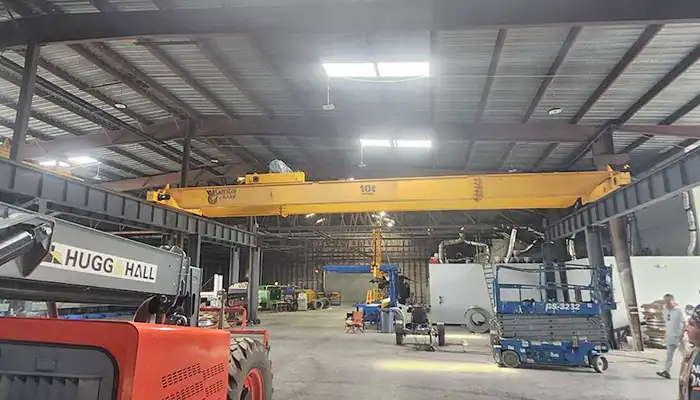
Affordable 10 ton double girder overhead crane with CD/MD hoist trolley, built for U.S. standards, ideal for construction and industrial lifting
Free consultation to Confirm Parameters & Specifications and Get
Latest Crane Price & Crane Rate.
- Types of overhead cranes : _______?
- Optional: Overhead travelling crane, goliath gantry crane,Slewing jib crane, Single girder or double girder crane,small portable crane or kbk crane, etc.
- Capacity of overhead crane: _______?
- Optional: 0.25ton, 0.5 ton, 1 ton, 2 ton, 3ton, 5 ton, 10 ton,15ton, 20ton, 25 ton, 30ton,35ton, up to 550ton, etc.
- Crane span & lifting height : _______?
- Crane travelling length : _____?
- Control of overhead crane:_______?
- Optional: pendant/ remote/cabin control
- Voltage supply of overhead crane:_____?
- Eg,: 380V50/60HZ,3Phase or others,etc.
- Application/usage of crane:_______?
- Eg,: Steel mill, ,injection mold, cement,stone, concrete,granite, general manufacturing, etc.
Just leave a message via the contact form and our hoist and crane engineer will contact you with in 24working hours.
Get In Touch
